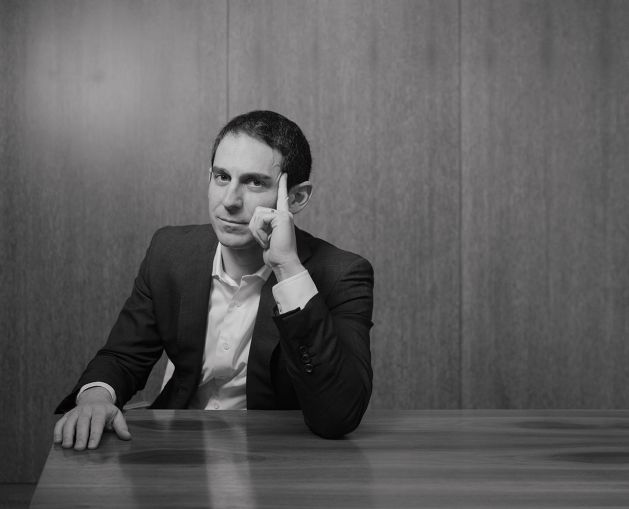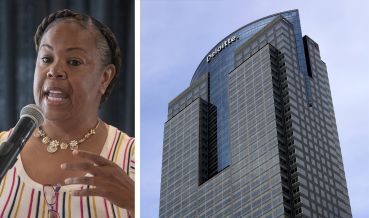Like Mike: Affinius Capital’s Michael Lavipour Is Leaning Into Market Opportunities
By Cathy Cunningham April 3, 2024 6:00 am
reprints
Michael Lavipour is a native New Yorker with a knack for real estate investment running through his blood — an apple that didn’t fall far from the tree in the Big Apple, if you will.
His father, David Lavipour, is the owner of Lavipour & Company — a developer, redeveloper and manager of grocery-anchored shopping centers — with 50 years of commercial real estate experience now behind him. As such, the young Lavipour was immersed into the heady world of real estate at an early age. He grew up on Manhattan’s Upper West Side, often traveling to meetings and site visits with his father. Later, he’d join the industry himself and put into practice the lessons his father taught him, including the importance of business interactions and some calculated risk taking.
Both teachings have played a critical role these past two years in Lavipour’s role as head of lending at Affinius Capital. For many lenders, it was a period of retrenchment, or of sitting on the sidelines entirely.
Not for Affinius.
As interest rates soared and the commercial real estate industry wobbled, Lavipour and his Affinius team instead got to work, bolstering their asset management capabilities while leaning into new and key origination opportunities, adding new borrower and lender partnerships along the way.
The firm grew out of a partnership between the real estate investment arm of USAA and its debt and equity arm, Square Mile Capital. Last year, USAA Real Estate and Square Mile were integrated to form Affinius Capital. Today, the firm invests up and down the capital stack and across the risk spectrum, and has in excess of $35 billion in assets under management globally.
Multifamily and industrial loan originations are what the firm predominantly gravitates toward — with recent loans including a $150 million acquisition financing in February for a 1.8 billion-square-foot industrial portfolio — but Affinius isn’t afraid of thinking, or playing, outside the box when the right opportunity arises.
With three interest rate cuts predicted later this year, a glimmer of hope is perhaps finally on the horizon for the commercial real estate industry, but the cuts won’t necessarily be a light switch for recovery, Lavipour said. Still, there’s plenty of opportunity to seize while the industry continues to find its footing, and Affinius is ready to pursue all that comes its way.
“I think the next 24 months will be a fantastic offensive opportunity within credit,” Lavipour said. “We have the house in order, and we’re going to go after it.”
This interview has been edited for length and clarity.
Commercial Observer: The past two years have been a wee bit hairy for the commercial real estate industry, to say the least. How were they for you and your team?
Michael Lavipour: The last two years have been really challenging for a variety of reasons, but they’ve also provided a great deal of opportunity, and markets like these tend to create separation between the “haves” and “have-nots” in our industry. We spent more time with our investors; we continued to write loans to our existing borrowers, sometimes in new forms; we picked up new target borrower clients when their lenders weren’t there for them; and we broadened our relationships with banks and insurance companies on the senior funding side. We also expanded our product array by matching investors’ needs to others’ needs in the market, and we have capital in every strategy and loan product. We’ve taken lumps on the office sector like others — for sure — but, overall, the success we’ve had these past two years has far outweighed the challenges. I think of Affinius as a net winner from this time period.
We’ve seen many of your competitors retreat in this environment. How palpable was the thinning of the playing field?
There’s been a demonstrable absence of some key competitors and, given how broad our mandate is, our competition isn’t just the alternative lenders, but the banks, too.
On the bank side, we’ve seen pullback for a variety of reasons, all tied to liquidity. You have pending stress on office assets — which I think will deepen this year — and higher risk-based capital charges on performing loans that were written in 2021 and 2022, during the acquisition boom when rates were lower.
Then there’s the lack of payoffs. So, there’s just a lack of liquidity holistically on the bank side. Given higher interest rates and lower corresponding values, banks often can’t lend the desired loan amount, either — but they’re thrilled to lend to groups like us who are strategically important to their business. We’ve picked up a number of new financing counterparties as a result.
Within the alternative lenders space there’s a bifurcation in terms of activity, too, because many of the real estate investment trusts and the open-ended funds have liquidity challenges associated with their current portfolios. They’re facing margin calls, and they can’t raise money in the public markets given valuations, so they’re also sidelined.
What are your thoughts on the new entrants popping up in the lending market?
Credit is certainly the flavor of the month, but I think I think a lot of the new entrants are having a tough time leveraging their positions in the bank market, because, if you’re a bank with limited liquidity and looking to lend, you’re going to lend to the people that have driven your business for the last 10 years, and not the new kid on the block. This happened leading up to the Global Financial Crisis, too. You saw equity players who couldn’t make returns work on the equity side dip their toes into credit, but it takes a lot of infrastructure, and business relationships with banks, and borrowers and other intermediaries and investors to create a sustainable credit business.
So, when I see a new equity player entering the credit marketplace, the first thing I think is, “What can I sell them? What will they think is priced well that I — in my capacity as a long-standing credit investor — think is a good risk to move to them?”
Have you formed new borrower or lender relationships during this period of dislocation?
There are definitely new relationships on the borrower side, largely driven by two things. In this environment, their banks can’t get to the leverage levels that they previously could or their lenders are on the sidelines. So, there’s an opportunity for us to acquire new clientele. It’s a hard thing to do in a fully functioning market, because people like to choose the path of least resistance, and they like to do negotiated transactions with those they trust. So, for us, we think this is a great time to be in client acquisition mode, and add some of the best borrowers and sponsors in the country.
On the lender side, we’re interacting with those counterparties very differently. Certainly, we want to borrow from the banks and the life insurance companies that we’re meeting with, but there are also opportunities to work with them on risk transfers. When you think about the bulk of lending activity in 2021 and 2022, it was acquisition loans on multifamily or industrial assets at the tightest cap rates ever. Some of those deals are underwater, some of them are close to being underwater, and some of them are totally fine, but they often can’t cover debt service where interest rates are today and that’s a catalyst for transactional activity. So, we’ve been interacting with banks on the risk transfer side.
Also, on the new partnership side, many banks have had their own origination staff service their clients for years but now — whether it’s due to the liquidity position of the bank, underwriting standards or the regulatory treatment — they can’t service those clients today. So, those banks are delivering those clients to groups like us and providing us with lender financing, or note-on-note. This way, they’re getting capital out the door and they’re also maintaining the relationships and taking the deposits. There are different ways to navigate relationships today, and, if you have a broad enough array of capital from a diversified investor base, and you’re savvy to what their needs are, you’ll find a way to do business.
Which asset classes are you leaning into?
We’re certainly leaning into residential and industrial, and I’d say our business is driven by those asset classes today. That being said, we’re open to hospitality and specialty asset classes to a lesser extent, so office or life sciences. We’ve been most active in development finance in the last handful of years, as the investment sales market spigot shut down, but much of our business today is actually the takeout of 2021- and 2022-vintage construction loans. Our business is a numbers game, and we’re trying to be less complex in the deals that we pursue.
We did actually purchase an office loan in December, on what we believe to be one of the best buildings in the market, and certainly a winner in office. Without getting into particulars, I think it was emblematic of a sale for optics reasons at a levered return that was — in our view — substantially higher than the perceived risk. There are sales that are being driven by reporting today, those that are being driven by risk-based capital treatment, and those that are being driven by credit. I think we’ll see many more of those in 2024.
It feels like the chickens are coming home to roost this year, with difficult portfolio decisions being made, and both assets and loans trading hands. Does 2024 feel like the year of the shakeout to you?
Yes. Equity owners are capitulating and selling at levels that are without profit, and trying to recover as much capital as possible, and I think you’re also going to see a thawing in the bank and insurance company loan sale market. I think most institutions are now saying: “It’s been long enough. Let’s take our lumps and move on in life and get back to doing what we do best.”
Your role encompasses both new originations and asset management. How are you splitting your time?
Last year, the split was probably 50-50, and this year I expect to spend much more time on the new business or offensive side. I think the inward focus on asset management paid off, however, as we effected a number of outcomes that de-risked our portfolio ahead of the continued valuation declines. We retooled our organization really early, and were proactive and responsive. When the dust settles, I feel we will outperform as a result of all the work we put in on the asset management side.
What did that retooling look like?
We basically did three things.
We had four origination verticals, and we took one of the origination verticals offline and [Harris Neuberg, a managing director at the firm] who had the most experience in asset management and restructuring, historically, became permanently dedicated to asset management and restructuring.
We separately beefed up both our capital markets functions and our credit functions and added strong seconds to the leads in both.
Then, we conditioned all of our teams that their responsibilities were not just on the origination side, but also on the asset management side. Everyone on our team now spends a meaningful amount of their time on asset management, as well as new originations. And, I think what that did is, we now know the nooks and crannies of each position, and how the sponsors and banks will react to different events.
Now, it’s a lot more about monitoring our positions, but less triage and less action— which is great, because I think the next 24 months will be a fantastic offensive opportunity within credit. We have the house in order, and so we’re going to go after it.
What a great training ground for junior staff to learn the asset management side, too.
There couldn’t be a truer statement. We’re already starting to see it impact the way that people evaluate and underwrite risk on new transactions. You almost can’t point to one massive lesson learned, but rather so many small ones: Did you have a hook to force a restructure early before values declined and before perceptions changed? Did you have the right warning mechanisms in place to say, “Maybe we should think about selling this to someone who’s a new entrant in the marketplace?” There are so many things learned in asset management that ultimately make people better investors.
Any high-level predictions on how the rest of this year will play out in terms of transaction activity?
Nobody knows how many interest rate cuts will occur, but it does seem pretty clear now that we’re going to start trending downward, and that’s the critical piece. I think, with stability, you’ll see transactions, and with transactions come opportunities for those who are well capitalized to take advantage of them, either on the debt or the equity side. It’s not a light switch, but I do think we’ll see a slow progression towards a healthier market with good opportunity in the interim. In terms of our lending activity, I expect it to pick up somewhat materially from last year, and our pipeline is suggesting that it will do just that.
You’ve transacted through cycles. Any big lessons from the past two years?
Some lessons are just recurring lessons that you forget sometimes and you have to come back to. Sponsorship matters, the real estate matters, and senior funding durability matters. Second, and this is more nuanced, when the market turns, you have to make decisions based on the facts on the ground and not what you hope them to be in the future. Sometimes it’s challenging to reset expectations, but when Affinius did that, and we did it in the most sober of ways, it led to the best outcomes, saved us the most money, and protected most of our investors’ capital. As Tom Burns on my team always likes to say, “Fast-forward the videotape,” and I think once we fast-forward the videotape and everything is realized, we will be deemed an outperformer because we were sober in our approach, and took the shots as they came.
You’re a New Yorker. Where in the city did you grow up, and what was your path to real estate?
I grew up on the Upper West Side, although I moved down to Tribeca, which is where I live now. In terms of how I got into real estate, my dad’s been in the real estate business for 50 years. He was originally a lender at Chase, then a broker out on his own, and he ultimately became a shopping center developer.
In the early days, I did a lot of traveling with him to site visits and meetings with lenders or partners. He’s been a mentor to me and I’ve really emulated his approach to business. I’ve learned a lot from him, especially his approach to business interactions, and his philosophy on risk taking. One example, which I actually use in my day to day, is to always focus on what someone on the other side of a transaction is looking for, and try to deliver it to them without them asking for it. So, make them feel like you have their interests at heart in the deal that you’re trying to cut. And, when taking a risk, think about the worst-case scenario outcome. If it’s palatable, just go for it. Those are two things I learned from my dad at a pretty young age.
I’ll have lunch with him once a month and just talk about business building, and examples of risks he took at various points in his career, and why he made those decisions. That back-and-forth dialogue has been so special to me. He’s turning 80 this year, and often, early in my career, people approached me and asked if I was related to him, because Lavipour is a pretty uncommon name. They would always tell me a fantastic story about him, which was really fun for me.
Where did you get your career start?
I started my career at Credit Suisse First Boston. I worked for Rodney Schiffer, on his originations team. I was there for a lot of the high-flying years leading up to the GFC and, then, when the downturn came, I was one of 10 people who were retained to work out the bad assets at Credit Suisse. So I gained a lot of workout and restructuring experience from that time. When the market started to open up again, I actually ended my time at Credit Suisse with a six-month stint on the capital markets desk, basically selling mezzanine and B notes and everything that wasn’t securitizable.
One of our clients was Redwood Trust. They were opening up a New York office, and they wanted someone to effectively cover the Northeast. For me, I had a ton of analytical experience, then a lot of restructuring experience, but I didn’t really have clients experience in originating and sourcing. And, at the time, Redwood was one of three or four players in the mezz marketplace. It sounds crazy today, given how many there are now, but back then you had Blackstone, you had RCG Longview, you had Apollo, and then you had Redwood and that was about it. I thought, “Hey, we can be a relevant counterparty in the marketplace to brokers and borrowers and investment banks.” And so I spent two years there, did a lot of business, and created a lot of relationships that way.
What appealed about your move to Affinius — then Square Mile — in 2013?
I really wanted to build a business. My dad built a business, and he built his from scratch, so super entrepreneurial. I also wanted it to be entrepreneurial, but with some level of security in the sense of an established platform. Square Mile had a meaningful investment from USAA Credit.
So there was capital, and a seed portfolio, even though it wasn’t big. There were already assets on the books, and it was pretty much a blank canvas. The founders of Square Mile, particularly Craig Solomon, were entrepreneurial — so I jived with that — and then I had also known Jeff Fastov throughout the years, going back to his days at Goldman Sachs and also spent some time with him at Credit Suisse. So, the opportunity to partner with him was very appealing to me too.
What keeps you busy outside of work?
As I mentioned, I live in Tribeca and I’m married with two boys — aged 9 and 6. They both go to school on the Upper East Side, and I take them there on the subway every day that I’m around and not traveling for work. Otherwise, I love to ski, and I’m heading to Deer Valley tomorrow with the family for the week, which I’m really looking forward to.


